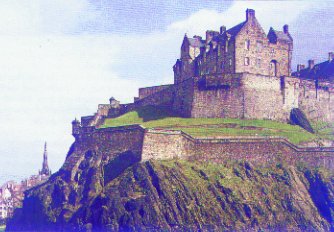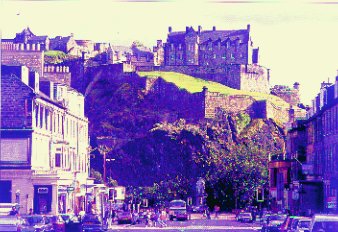
Edinburgh Castle.
Edinburgh is a hilly city! Like Rome it is built on seven hills, of which the most interesting (although not the biggest) is Castle Hill. This is so-called because there is a dirty great castle on top - who said there was a lack of imagination in Scotland!
 The Castle is undeniably picturesque, but it was built as a strictly functional fortification and is still a working military establishment. Throughout it's history the Castle has been often besieged, and while starvation and occasionally treachery have forced garrisons to surrender, it has never been successfully stormed.
The Castle is undeniably picturesque, but it was built as a strictly functional fortification and is still a working military establishment. Throughout it's history the Castle has been often besieged, and while starvation and occasionally treachery have forced garrisons to surrender, it has never been successfully stormed.
The present-day Castle presents a rather unusual mixture of architectural styles from it's oldest surviving part, the tiny St. Margaret's Chapel, to it's more modern additions such as the statues of the Scottish heroes, Bruce and Wallace, which flank the Gatehouse. Nothing now remains of the very earliest buildings, in fact the present military defences only date from the middle of the 14th. century when King David II returned from captivity. Since then it was developed into Scotland's premier castle with the dual purpose of fortress and royal palace and now into it's position as National Monument and backdrop for the Tattoo. At various times plans have been put forward for bizarre improvement schemes which seem to have the aim of turning it into some sort of giant advertising hoarding or imitation Disneyland attraction, but thankfully these mental abberations have been resisted so far.
Once you have paid for your ticket you are free to wander round the Castle by yourself but there are guided tours which are very interesting if you can understand the commentary - one or two of the Guides seem to overdo the Scots accent.
 The entry to the Castle is by way of the Esplanade which was built in the 1750's as a parade ground but nowadays is more often pressed into service as a car and coach park when the Tattoo isn't cluttering it up with scaffoldings. An interesting feature of the Esplanade is the ornamental drinking fountain in the Northeast corner, which marks the site where around 300 women were burned as witches between 1479 and 1722.
The entry to the Castle is by way of the Esplanade which was built in the 1750's as a parade ground but nowadays is more often pressed into service as a car and coach park when the Tattoo isn't cluttering it up with scaffoldings. An interesting feature of the Esplanade is the ornamental drinking fountain in the Northeast corner, which marks the site where around 300 women were burned as witches between 1479 and 1722.
Entry to the Castle proper is through the Gatehouse and over the last drawbridge to be built in Scotland, these being romantic-style additions of the 1880's. The road then winds uphill through the Portcullis Gate which has a rather strange upper storey which was added in Victorian times. The road passes the six-gun Argyle Battery, the tea-room (variously a cart-shed, barracks and ammunition store in past lives) and the Governor's House which is now the Officer's Mess for members of the Garrison, and the rather austere New Barracks (built in the 1790's). You then pass through Foog's gate into the highest part of the Castle - and before you ask, I don't know why it's called Foog's Gate (I wouldn't know a Foog if it bit me!).
At the Eastern end of the citadel stands St. Margaret's Chapel, the oldest surviving building in the Castle, and probably in the whole of Edinburgh dating from the tweflth Century. This tiny building was used as an ammunition store for over 300 years before its rediscovery in 1845. The battlements outside the chapel offer a superb panoramic view over Edinburgh and swing round to the Mill's Mount Battery which features a reasonably modern field gun amid the more ancient barrel loaders. This gun is fired daily at exactly One o'clock and it is a reasonably accurate method of identifying tourists in the city centre - they're the ones looking round for the cause of the explosion while the locals are checking their watches!








 The Castle is undeniably picturesque, but it was built as a strictly functional fortification and is still a working military establishment. Throughout it's history the Castle has been often besieged, and while starvation and occasionally treachery have forced garrisons to surrender, it has never been successfully stormed.
The Castle is undeniably picturesque, but it was built as a strictly functional fortification and is still a working military establishment. Throughout it's history the Castle has been often besieged, and while starvation and occasionally treachery have forced garrisons to surrender, it has never been successfully stormed. The entry to the Castle is by way of the Esplanade which was built in the 1750's as a parade ground but nowadays is more often pressed into service as a car and coach park when the Tattoo isn't cluttering it up with scaffoldings. An interesting feature of the Esplanade is the ornamental drinking fountain in the Northeast corner, which marks the site where around 300 women were burned as witches between 1479 and 1722.
The entry to the Castle is by way of the Esplanade which was built in the 1750's as a parade ground but nowadays is more often pressed into service as a car and coach park when the Tattoo isn't cluttering it up with scaffoldings. An interesting feature of the Esplanade is the ornamental drinking fountain in the Northeast corner, which marks the site where around 300 women were burned as witches between 1479 and 1722.


